2014 MITSUBISHI OUTLANDER SPORT inflation pressure
[x] Cancel search: inflation pressurePage 165 of 388
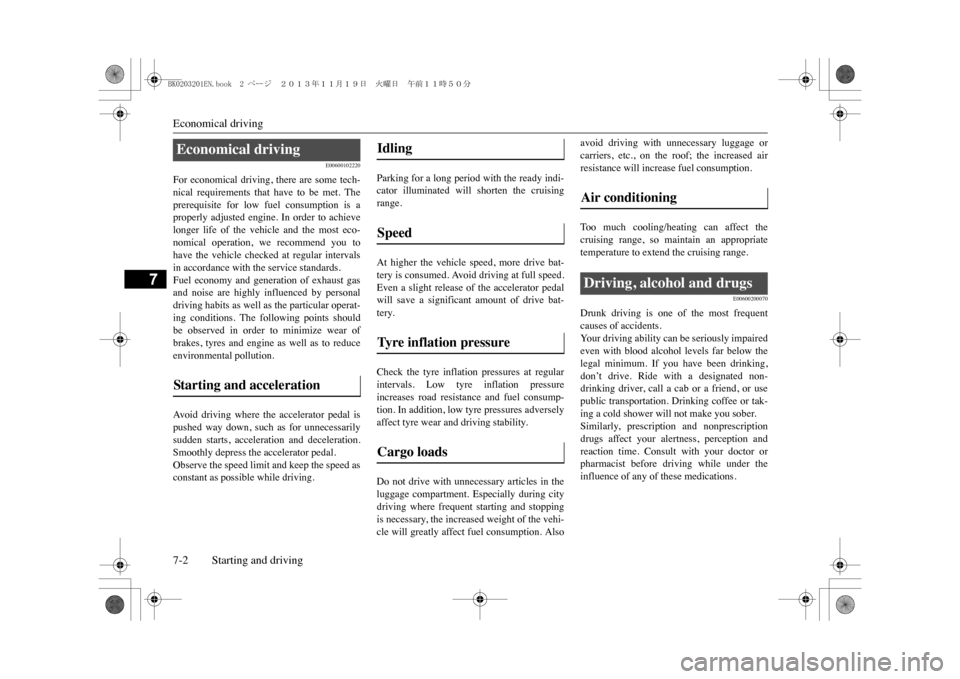
Economical driving7-2 Starting and driving
7
E00600102220
For economical driving, there are some tech-nical requirements that have to be met. Theprerequisite for low fuel consumption is aproperly adjusted engine. In order to achievelonger life of the vehicle and the most eco-nomical operation, we recommend you tohave the vehicle checked at regular intervalsin accordance with the service standards.Fuel economy and generation of exhaust gasand noise are highly influenced by personaldriving habits as well as the particular operat-ing conditions. The following points shouldbe observed in order to minimize wear ofbrakes, tyres and engine as well as to reduceenvironmental pollution.Av o i d d r i v i n g w h e r e t h e a c c e l e r a t o r p e d a l i spushed way down, such as for unnecessarilysudden starts, acceleration and deceleration.Smoothly depress the accelerator pedal.Observe the speed limit and keep the speed asconstant as possible while driving.
Parking for a long period with the ready indi-cator illuminated will shorten the cruisingrange.At higher the vehicle speed, more drive bat-tery is consumed. Avoid driving at full speed.Even a slight release of the accelerator pedalwill save a significant amount of drive bat-tery.Check the tyre inflation pressures at regularintervals. Low tyre inflation pressureincreases road resistance and fuel consump-tion. In addition, low tyre pressures adverselyaffect tyre wear and driving stability.Do not drive with unnecessary articles in theluggage compartment. Especially during citydriving where frequent starting and stoppingis necessary, the increased weight of the vehi-cle will greatly affect fuel consumption. Also
avoid driving with unnecessary luggage orcarriers, etc., on the roof; the increased airresistance will increase fuel consumption.To o m u c h c o o l i n g / h e a t i n g c a n a ff e c t t h ecruising range, so maintain an appropriatetemperature to extend the cruising range.
E00600200070
Drunk driving is one of the most frequentcauses of accidents.Yo u r d r i v i n g a b i l i t y c a n b e s e r i o u s l y i m p a i r e deven with blood alcohol levels far below thelegal minimum. If you have been drinking,don’t drive. Ride with a designated non-drinking driver, call a cab or a friend, or usepublic transportation. Drinking coffee or tak-ing a cold shower will not make you sober.Similarly, prescription and nonprescriptiondrugs affect your alertness, perception andreaction time. Consult with your doctor orpharmacist before driving while under theinfluence of any of these medications.
Economical driving Starting and acceleration
Idling Speed Ty re i n f l a t i o n p r e s s u r e Cargo loads
Air conditioning Driving, alcohol and drugs
BK0203201EN.book 2 ページ 2013年11月19日 火曜日 午前11時50分
Page 185 of 388
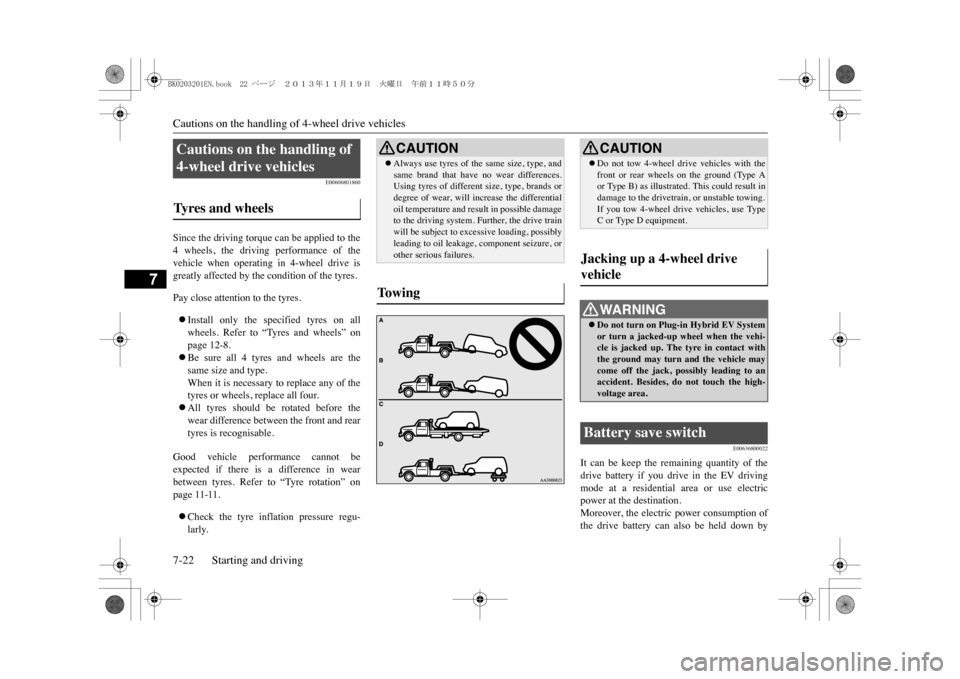
Cautions on the handling of 4-wheel drive vehicles7-22 Starting and driving
7
E00606801860
Since the driving torque can be applied to the4 wheels, the driving performance of thevehicle when operating in 4-wheel drive isgreatly affected by the condition of the tyres.Pay close attention to the tyres.�zInstall only the specified tyres on allwheels. Refer to “Tyres and wheels” onpage 12-8.�zBe sure all 4 tyres and wheels are thesame size and type.When it is necessary to replace any of thetyres or wheels, replace all four.�zAll tyres should be rotated before thewear difference between the front and reartyres is recognisable.
Good vehicle performance cannot beexpected if there is a difference in wearbetween tyres. Refer to “Tyre rotation” onpage 11-11.�zCheck the tyre inflation pressure regu-larly.
E00636800022
It can be keep the remaining quantity of thedrive battery if you drive in the EV drivingmode at a residential area or use electricpower at the destination.Moreover, the electric power consumption ofthe drive battery can also be held down by
Cautions on the handling of 4-wheel drive vehicles Ty r e s a n d w h e e l s
CAUTION�zAlways use tyres of the same size, type, andsame brand that have no wear differences.Using tyres of different size, type, brands ordegree of wear, will increase the differentialoil temperature and result in possible damageto the driving system. Further, the drive trainwill be subject to exce
ssive loading, possibly
leading to oil leakage, component seizure, orother serious failures.
To w i n g
CAUTION�zDo not tow 4-wheel driv
e vehicles with the
front or rear wheels on the ground (Type Aor Type B) as illustrated. This could result indamage to the drivetrain, or unstable towing.If you tow 4-wheel drive vehicles, use TypeC or Type D equipment.
Jacking up a 4-wheel drive vehicle
WA R N I N G�zDo not turn on Plug-in Hybrid EV Systemor turn a jacked-up wheel when the vehi-cle is jacked up. The tyre in contact withthe ground may turn and the vehicle maycome off the jack, possibly leading to anaccident. Besides, do not touch the high-voltage area.
Battery save switch
BK0203201EN.book 22 ページ 2013年11月19日 火曜日 午前11時50分
Page 322 of 388
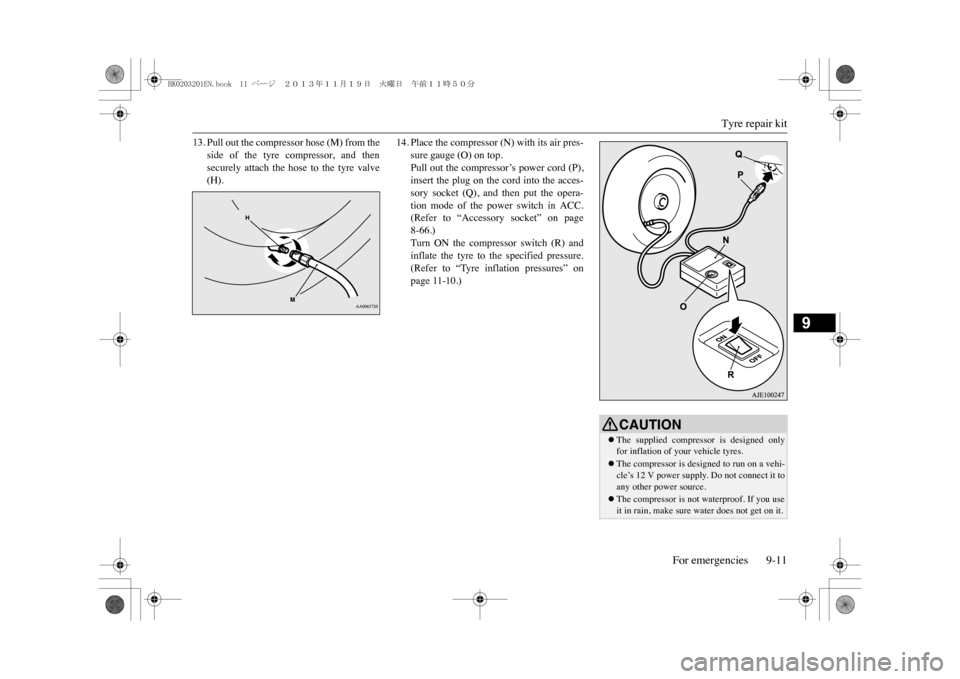
Tyre repair kit
For emergencies 9-11
9
13. Pull out the compressor hose (M) from the
side of the tyre compressor, and thensecurely attach the hose to the tyre valve(H).
14. Place the compressor (N) with its air pres-
sure gauge (O) on top.Pull out the compressor’s power cord (P),insert the plug on the cord into the acces-sory socket (Q), and then put the opera-tion mode of the power switch in ACC.(Refer to “Accessory socket” on page8-66.)Turn ON the compressor switch (R) andinflate the tyre to the specified pressure.(Refer to “Tyre inflation pressures” onpage 11-10.)
CAUTION�zThe supplied compress
or is designed only
for inflation of y
our vehicle tyres.
�zThe compressor is designed to run on a vehi-cle’s 12 V power supply. Do not connect it toany other power source.�zThe compressor is not waterproof. If you useit in rain, make sure water does not get on it.
BK0203201EN.book 11 ページ 2013年11月19日 火曜日 午前11時50分
Page 329 of 388
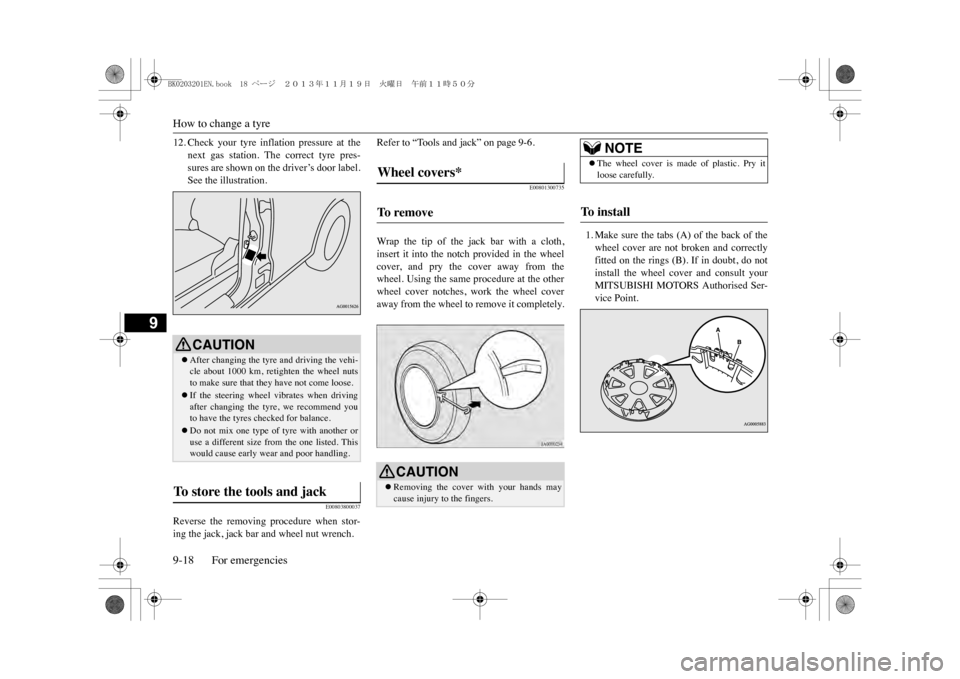
How to change a tyre9-18 For emergencies
9
12. Check your tyre inflation pressure at the
next gas station. The correct tyre pres-sures are shown on the driver’s door label.See the illustration.
E00803800037
Reverse the removing procedure when stor-ing the jack, jack bar and wheel nut wrench.
Refer to “Tools and jack” on page 9-6.
E00801300735
Wrap the tip of the jack bar with a cloth,insert it into the notch provided in the wheelcover, and pry the cover away from thewheel. Using the same procedure at the otherwheel cover notches, work the wheel coveraway from the wheel to remove it completely.
1. Make sure the tabs (A) of the back of thewheel cover are not broken and correctlyfitted on the rings (B). If in doubt, do notinstall the wheel cover and consult yourMITSUBISHI MOTORS Authorised Ser-vice Point.
CAUTION�zAfter changing the tyre and driving the vehi-cle about 1000 km, reti
ghten the wheel nuts
to make sure that they have not come loose.�zIf the steering wheel vibrates when drivingafter changing the tyre, we recommend youto have the tyres checked for balance.�zDo not mix one type of
tyre with another or
use a different size from the one listed. Thiswould cause early wear and poor handling.
To s t o r e t h e t o o l s a n d j a c k
Wheel covers* To r e m o v e
CAUTION�zRemoving the cover with your hands maycause injury to the fingers.
NOTE
�zThe wheel cover is made of plastic. Pry itloose carefully.
To i n s t a l l
BK0203201EN.book 18 ページ 2013年11月19日 火曜日 午前11時50分
Page 351 of 388

Tyres11-10 Maintenance
11
E01001402726
*: Above 160 km/hCheck the tyre inflation pressure of all the tyres while they ar
e cold; if insufficient or excessive, adjust to the specified v
alue.
After the tyre inflation pressure has been adjusted, check the tyres for damage and air leaks. Be sure to put caps on the valve
s.
E01001801970
Check the tyres for cuts, cracks and otherdamage. Replace the tyres if there are deep
cuts or cracks. Also check each tyre forpieces of metal or pebbles.The use of worn tyres can be very dangerousbecause of the greater chance of skidding orhydroplaning. The tread depth of the tyresmust exceed 1.6 mm in order for the tyres tomeet the minimum requirement for use.Tread wear indicators will appear on the sur-face of the tyre as the tyre wears, therebyindicating that the tyre no longer meets theminimum requirement for use. When thesewear indicators appear, the tyres must bereplaced with new ones.When replacement of any of the tyres is nec-essary, replace all of them.
Ty r e i n f l a t i o n p r e s s u r e s
Ty re s i z e
Front
Rear
215/70R16 100H
2.4 bar (35 PSI) [240 kPa], 2.6 bar (38 PSI) [260 kPa]
*
225/55R18 98H
2.4 bar (35 PSI) [240 kPa]], 2.6 bar (38 PSI) [260 kPa]
*
Wheel condition 1- Location of the tread wear indicator2- Tread wear indicator
CAUTION�zAlways use tyres of the same size, sametype, and same brand, and which have nowear differences. Using tyres of differentsize, type, brands or
degree of wear, will
increase the differential oil temperature,resulting in possible damage to the drivingsystem. Further, the drive train will be sub-jected to excessive loading, possibly leadingto oil leakage, component seizure, or otherserious faults.
BK0203201EN.book 10 ページ 2013年11月19日 火曜日 午前11時50分
Page 386 of 388

Alphabetical index
13-5
13
Stopping the Plug-in Hybrid EV System 7-12Storage spaces
....................................
8-68
Sun visors
..........................................
8-64
Sunroof
..............................................
4-31
Supplemental restraint system
..............
5-21
Servicing
.......................................
5-30
System check screen
...........................
6-12
T
Tail lamps
Bulb capacity
...............................
11-22
Replacement
................................
11-27
Tailgate
..............................................
4-16
Taking your vehicle overseas
...............
2-16
Tank capacity
.....................................
2-13
Time Setting
.......................................
8-36
Tools
...................................................
9-7
Storage
............................................
9-6
Towing
..............................................
9-19
Towing caravans and trailers
................
7-71
Transfer oil
......................................
12-10
Turn/Lane-change signals
....................
6-45
Turn-signal indicator lamps
.................
6-36
Tyre repair kit
.......................................
9-7
Tyres
.................................................
11-9
How to change a tyre
......................
9-14
Inflation pressures
.........................
11-10
Rotation
.......................................
11-11
Size (tyre and wheel)
......................
12-8
Snow tyres
....................................
11-11
Tread wear indicators
....................
11-10
Tyre chains
...................................
11-12
Tyre repair kit
..................................
9-7
U
USB input terminal
.............................
8-61
How to connect a USB memory
.......
8-61
How to connect an iPod
..................
8-62
V
Vanity mirror lamp
Bulb capacity
................................
11-23
Vehcile data label
...............................
12-2
Vehicle care precautions
.....................
10-2
Vehicle dimensions
............................
12-4
Vehicle identification number
..............
12-2
Vehicle information code plate
............
12-2
Vehicle labeling
.................................
12-2
Vehicle mass
......................................
12-5
Vehicle performance
...........................
12-5
Ventilators
...........................................
8-2
W
Warning lamps
...................................
6-37
Washer
Fluid
...................................
11-7
, 12-10
Switch
...........................................
6-51
Washing
.............................................
10-3
Waxing
..............................................
10-5
Wheel
Covers
...........................................
9-18
Specification
..................................
12-8
Wiper
Rear window
..................................
6-51
Windscreen
....................................
6-47
Wiper blades
................................
11-12
Wiper deicer switch
............................
6-53
BK0203201EN.book 5 ページ 2013年11月19日 火曜日 午前11時50分
Page 388 of 388
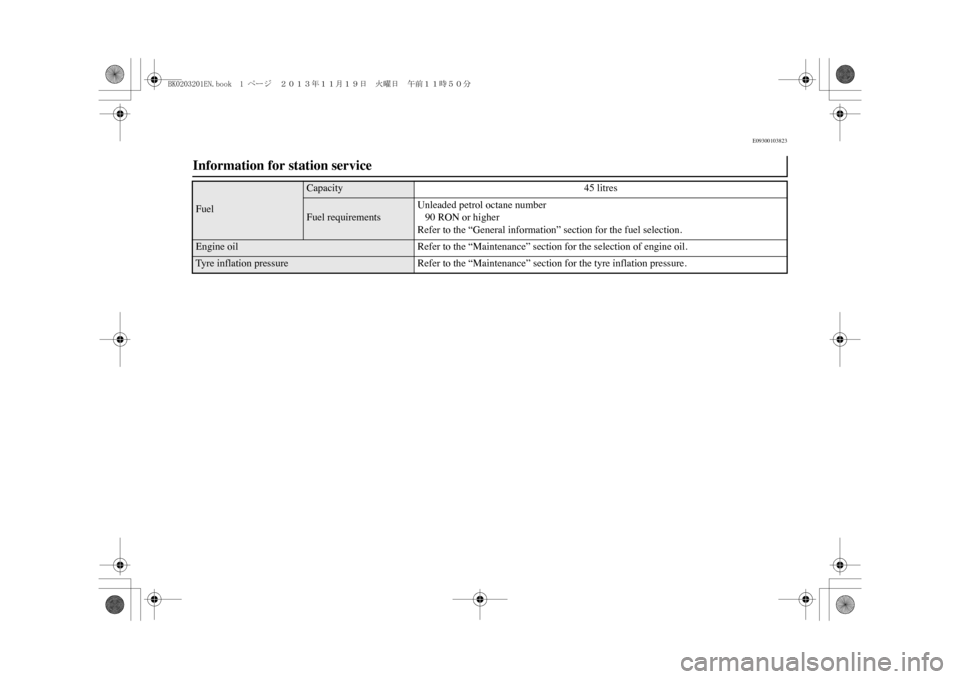
E09300103823
Information for station service Fuel
Capacity
45 litres
Fuel requirements
Unleaded petrol octane number 90 RON or higherRefer to the “General information” section for the fuel selection.
Engine oil
Refer to the “Maintenance” section for the selection of engine oil.
Ty r e i n f l a t i o n p r e s s u r e
Refer to the “Maintenance” section for the tyre inflation pressure.
BK0203201EN.book 1 ページ 2013年11月19日 火曜日 午前11時50分